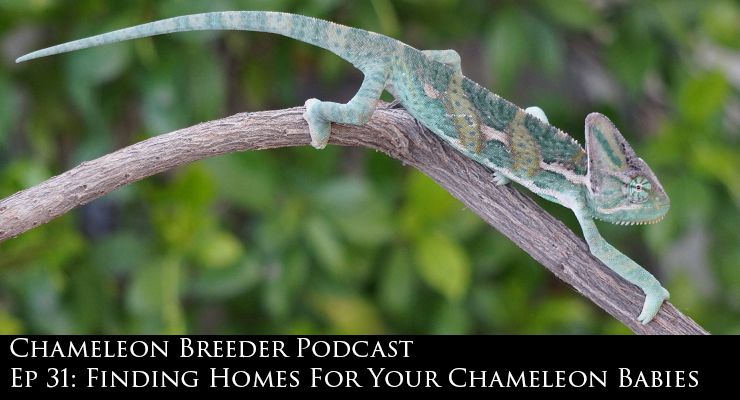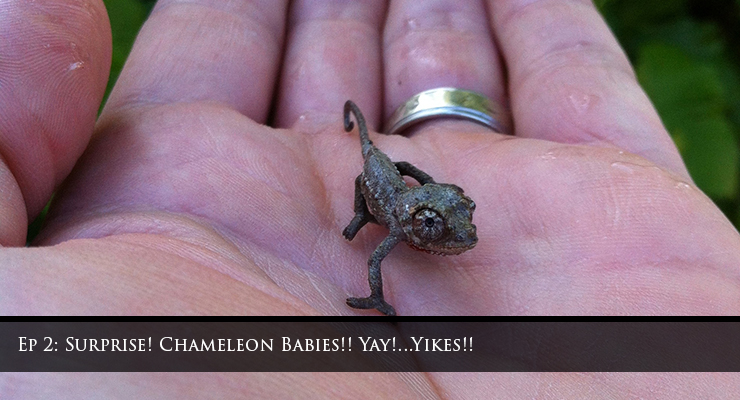Ep 31: Finding Homes for your Baby Chameleons
Listen Here!
Today we talk about finding, or creating, good homes for the chameleon babies you raise up. A big part of this is setting yourself up so you do not get pressured to make a quick sale. That way you can be selective as to where you sell the baby chameleons you worked so hard to raise up.
Transcript (more or less)
Show notes : .
Business Insight for your mini-MBA lesson for the day!
Facebook operating expenses for Q4 2015 came in at $3.28 billion. That is about $1 billion per month. It takes a lot to run the social media platform that we all enjoy for free!
Does anyone remember Border’s Bookstores? They and Barnes & Noble ruled the big box book stores until the Great Recession hit. Barnes & Noble survived and Borders didn’t. Borders went down for a variety of reasons. While we can look back and debate their decisions that led to not having enough money to cover their debt payments the fact is that they had become too big and didn’t have the money to sustain their debt payments. We can do the same thing on a personal scale when we breed too many chameleons and end up with more babies than we can take care of. But for those who would like to learn more about Borders and their fall, you can check out this link.
Five Reasons Borders Went Out Of Business
Show Transcript (More or Less)
Introduction
Hello chameleon wranglers, Today we are going to be talking about breeding project. More specifically, how you can best find good homes for your baby chameleons.
Breeding chameleons is an exciting project. And, if you are successful, you will soon find yourself in the position of sending your chameleon babies to new homes. And this becomes a point of great thought. How do I make sure I send these to the right homes? You have worked so hard to raise these chameleons up. And you now have a better appreciation for how much it really costs to do it! The last thing you want to do it send them off to a home where they will not get as good of care as they had with you.
And this is what today’s podcast is about. Finding the right home for your baby chameleons. Now, I am going to tell you something upfront. In the end, success in selling your chameleons probably won’t come as much from finding the right homes, but in your ability to create the right home! We’ll talk about both finding and creating.
Standards, Capitalism, and the Death of Idealism
But first, let’s talk about maintaining control of your standards. Let’s acknowledge that for some breeders, the standard for the right home comes down to whomever has money. This podcast is not for those individuals. That formula is pretty easy. Fill cages with as many females as will fit and push the females to produce as many clutches as possible. Females only need to live long enough to produce two to four clutches. Sell babies as soon as they can ship and not die. Sell retail whatever you can and wholesale out the back door whatever you can’t sell retail. You are such an awesome breeder that you have hordes of eggs in the incubator right behind this clutch. And why not? Chameleons are like printing money, right? You have to blow everything out quickly because you have those one or two or five clutches of eggs hatching right behind this one. Keep track of the number of babies produced in your mill because that is how you measure how awesome you are. You’ll need that number to bash anyone that suggests that your methods are suspect. Heck, you’ve produced 3000 babies to their 100. So obviously your husbandry is superior, right? Babies not selling quick enough? Lower prices! That is the capitalist way! You captain of industry, you!
As I said, this podcast is not for those individuals. They have it figured out anyways. This podcast episode is for the breeder that is looking to hang on to quality over quantity and realizes that doing both is exponentially more difficult. This podcast is for the breeder that is concerned not only about the quality of their chameleons, but the quality of the home their chameleons go to.
And, first a side note. Most breeders start off with a healthy dose of idealism and only become the mass producer when they fall into the trap of “more is better”. There is a market for mass produced chameleons. But it is a completely different world than producing and raising up the single clutch that was such a great experience that you wanted to do it again. It is too easy for the chameleons to start to become commodities. They become numbers. And it is much easier to produce 100s of babies than it is to properly care for hundreds of babies. You can get yourself into a bad place very easily. The bad place is that it is no longer fun and you are forced to sell without any knowledge as to where the chameleons will eventually end up. You start to become detached from the chameleons because you can’t focus so much on individuals. They are just bins of babies. Obviously, the tone in my voice implies I am not impressed with many of these operations. There are precious few that have been able to keep quality with quantity. Most compromise quality in hidden ways that you don’t see. I’ll leave it at that for now. My bringing it up in this episode is more to be a warning for the enthusiastic beginning breeder with visions of where they can take their hobby. Beware as you can easily scale up your operation and quickly lose the standards that you started with.
Now back to those standards. A typical standard that beginning breeders start of with is wanting to make sure that the home their baby goes to is as quality as the effort put into raising this baby. I have to say that this is one of the first things to fall when reality comes a knocking. But it falls not because it is unreasonable, but because the breeders with those standards are not prepared to back them up with facility structure.
For the purposes of this conversation, I’ll summarize the three month panic again. That is when the chameleon’s anti-social nature spills into becoming overtly physical. Before the three month period, the dominance and bullying between babies is subtle and can go unnoticed by those not attuned to these interactions. At around the three month point, you will get more biting and tail nipping and there is noticeable physical damage. It is at this point that the typical breeder starts panicking because they don’t have the space to separate the babies and they start getting “B” grade animals which means damaged and they start noticing the submissive ones not growing as fast or not coloring up because they have accepted their submission. Now, let me say that each clutch has their own dynamic. I have had clutches that have kept the peace and have given me little problem. And then I have had clutches that thought they were in the Hunger Games. And, of course, you have every shade in between. If you have the Brady Bunch clutch then you talk about what an awesome breeder you are that you have no problems with co-habitation (it must be your natural skill). If you have a couple of bad apples (in other words, the combination of an alpha chameleon and another chameleon that disagrees with the social structure) then you can have problems that can seem to start overnight. And if you are not prepared with proper caging then the panic starts. You end up getting rid of them at any price as soon as possible and any standard you started off with has flown the coop in order to be done with the stress and cost of keeping the now juveniles.
So how do we avoid the three month panic? This is simple, but difficult to implement. You need a bank of cages for babies and a bank of grow out cages. The formula is simple. The length of time you can hold onto to your standards is in direct proportion to the number of grow out cages you have. A grow out cage is a cage big enough for your chameleon to reach at least young adulthood. You need to make sure you do not reach a point where you have to sell because you do not have the space. The more cage space you have the longer you can hold out.
Wait a minute, hold out against what? Isn’t it easy to sell panther chameleons? You see it happening all the time on Facebook. And, heck, some places have a waiting list! These things should fly off the shelves, so to speak! The truth is that until you have a reputation in the industry things will not be flying off the shelf. And if you lower your prices and sell in bulk then it is difficult for you to get that reputation because that is what many others are doing when they run into the same situation you find yourself in. To develop that critical reputation you need to differentiate yourself in some way. Selling your one clutch over, say six months is one way of doing that. Making it quietly known that you care enough that your babies will only go to quality homes will bring out people that care themselves. Don’t do this in a self-righteous sort of way, just make it known you would like to pre-screen your buyers.
So I am going to suggest that if you want to start a breeding business, keep it small and manageable. If you create an operation that centers around pushing one clutch at a time through and sell over three to six months you will be able to maintain quality. Every breeding operation has the 0 to 3 month caging taken care of. If you want to take a step towards differentiation then invest in a bank of grow out cages. The standard 20” cage will get panthers to about six months while the 36” can get them to about 12 months. These are not ideal dimensions, but if the chameleon grows up in their grow out cage from three months on then most will be used to it. Just make sure they go into a larger cage when they go to their forever home. To pull this off you would have to invest in a bank of 6 to 9 cages. The more cage space you have the longer you will be able to wait for the right buyer before compromising. And if you resist the urge to double or triple production you will be able to develop a strong reputation in the community for the highest standards. The fastest way to ruin success is to suddenly scale it upwards beyond your ability to maintain. This is a basic business trap and one that is fallen into by many businesses. Remember the book seller Borders? They went out of business while Barnes & Noble remained in business because Borders was in the midst of an expansion and then the recession crippled their ability to pay their loans. Of course, as with anything like this, that is an extreme simplification of the situation. And I will be easier on the Border’s executive team than the business pundits were and say I don’t know that anyone would have made a different growth decision with the information available at the time. But their growth became unsustainable. Don’t let this happen to you! That’s right. On the Chameleon Breeder Podcast you never know when you might get drama, poetry or even a mini-MBA class.
Anyway, it will take time for that reputation to develop, but be patient. Reputations that develop over time are the strongest – and they are the ones that are sustainable. The patient breeder will be able to put the proper value on quality and resist the rush to scale up operations by holding back ten females from the first clutch and jumping right into the 300 egg club. For those new to my unique observations, I have noticed a number of would be big time breeders bragging about having 300 eggs in their incubator before disappearing from view. Remember how it is much easier to produce eggs than it is to raise up babies to three months old? Just stay firmly grounded and you can avoid being eaten up by your own success! It is a real thing!
Application process
So, say we have the breeding set-up that allows for a prolonged siege. We now have to figure out how to find the right buyers.
A typical approach to this dilemma is to create an application form and interview each person interested in buying a chameleon from you. This creates an extra layer of work for you and certainly weeds out a majority of buyers! Now, most people are not interested filling out an application and, unless you have a special species or bloodline, you may find few takers. And now you are surprised to find out that the number of people that applaud you for having such high standards greatly outweigh the number of people who will fill out your application and accept your judgment on their husbandry. Would you like to see this in action? I am sure there are others, but the one person I know who has a working, time tested application process is Elisa Hinkle at ChamEO. You’ll find it at chamlist.org. To adopt a rehabilitated chameleon you need to prove that you are knowledgeable and have the proper setup. You apply on a public forum, post images of your set-up and take feedback from Elisa and other forum members. How many people are willing to go through that? Well, if you want only the best then there you go. But you can go on and look at what she has to put into it and how few people make it through. She can do that though, because she has the caging necessary to hold the rehabilitated chameleons until she finds the right home for them. ChamEO is a working model of what it takes to maintain high standards. Now, you don’t have to have the rigorous standards that ChamEO has. ChamEO charges only an adoption fee of $25 so is a magnet for people wanting cheap chameleons. This type of person is not likely to spend what it takes to do a proper set-up or take their chameleon to the vet. Elisa’s mission is to place chameleons where they will have a high quality of life – not just to move inventory. So an intensive application process is necessary to ensure that the chameleon will not need to be rescued yet again.
Price
As you will be charging full price, most of the bargain hunters will not come your way. A, yes, you will be charging full market value because if you focus on quality then you deserve to be able to maintain the price.
Having a solid grow out focus in your breeding plan is also a good defense against the standard negotiator that wants you to sell cheaper in price. If you are not set-up for the long haul it is then much easier to fall into the trap of selling for less than they are worth. It is interesting how potential buyers will berate you for charging high prices and actually be offended that you had the arrogance to charge what you are. Somehow you charging what you determine they are worth is considered “greedy”, while them trying to get them below that value is considered “savvy”. This is a manipulation. Don’t fall for it. If someone is trying to hustle you…sorry, negotiate a better deal for themselves, then you are at liberty to say “no thank you” if you are not panicking for space!
You will have to stand firm. Nobody cares how much you invested into raising up the babies correctly. Facebook spends roughly $1billion dollars a month keeping Facebook up and running smoothly so we can share photos of cats with witty sayings. And when we see an ad we are angered and morally outraged that it is mucking up our personal space that, of course, Facebook is providing us free of charge. So, don’t expect buyers to care that you switch out your UVB bulbs every six months and purchase the best supplements. And, no, it is not fair that the community will talk about how husbandry is so important, then leave your fairly priced babies to go buy a lower priced chameleon elsewhere. It gets even better when they come back to you for advice and husbandry training because their chameleon from Acme reptiles isn’t doing so well and you seem to know what you are doing so could you please help? And, yes, I wish I was kidding on this one.
Finding New Homes
Once you have your internal structure set up for long term keeping you can hunker down and locate the right homes. Of course, you’ll have to be active about this. We will need to find, or create, the right buyers!
First- “Finding”.
Finding the home implies that a home with good husbandry is out there and you just have to match up the timing of your availability and their purchase window. And with the internet that is much easier than it used to be. Knowledgeable keepers tend to congregate in certain social media sites, but, then again, so do your fellow breeders who are looking for those same knowledgeable keepers. So there is a steady flow of chameleons being made available. Given enough time, you’ll find a buyer for your chameleons. But you do have to wait until there is the right intersection of demand and your supply. You can talk about your clutch on social media. In fact, the best way to prime the sales is to let people follow the clutch progress and post baby pictures. Let people know that you’ll take orders starting at 2 months of age for shipping at 3 months old. You can even offer a discount for people that pre-order up until the 3 month point. Maybe 10% or even 20%? This is not a lowering of price because the buyer is paying ahead of time. As long as the price goes up to market level at the three month point, which is fair, you have just run a pre-sales campaign. For the benefit of you receiving money ahead of time you give them a discount. That becomes a benefit to both buyer and seller. Just make sure you have a 100% refund policy if you are not able to ship for whatever reason. The point of this is to have as many sold at the three month mark as possible. Once you hit three months the price goes back to fair market value and you hold that price for a month or three. Since you are now growing out any left overs, at six months the price goes up 10% or 20%. Once they start showing their colors or horns or whatever the characteristic of your chosen species the 10% or 20% is appropriate.
Second is “Creating” quality customers.
Quality customers can be created. And this is a great use of your time as a breeder. Creating a new home for your babies is taking the raw material of enthusiasm in people new to the chameleon world and attaching sufficient knowledge to it. There are plenty of people that are entering into the hobby on a regular basis. If you become proficient at helping a newcomer along, then not only will you have a customer, you will have a customer educated enough that you will feel good passing along one of your babies. This is accomplished simply by education. Something as basic and obvious as care sheets do wonders. If you have a gift for writing consider a blog. You find the method that works with your talents and offer it up. If content creation is not your strong suit then you can refer them to this podcast. Or to the Chameleons eZine. Select out your favorite podcast episodes and eZine articles, compile them in an email and use that as a research guide. Face to face (or phone or internet or whatever) discussions should be part of the process. It is by communication that you get a feel for your potential buyer. By directing your interested party to places where they can get a solid education in the basics, whether your website or an educational website, you can create quality customer and your chameleon’s forever home.
Part 2: Selling at Reptile shows.
As a hobbyist breeder selling on the internet you really don’t get that much new-to-reptiles impulse buying. Sure, there are the water bowl, no UVB, and bath giving factions out there, but if they have found you they are usually plugged into the chameleon community at some level. So you may argue about their husbandry conditions, but at least they have husbandry conditions to argue about.
On the other hand, as we head out of Spring we are heading into reptile show season. We will be getting more families that are chameleon curious. With more exposure in recent kid films, chameleons are getting a higher profile in the general populace. This has its advantages and disadvantages. There is not much we can do when these families walk into a pet store. It is hit and usually miss as to whether the employees actually know what they are talking about. They are just repeating what hey have been told to say by the owner who is just repeating what he was told by the manufacturer’s representative that is selling nightbulbs with chameleons printed on the packaging. But when these families walk into a reptile show we have a golden opportunity to educate before they purchase.
We are on the front lines either helping them make that decision or, unfortunately, working with them after someone else has sold them a chameleon, or chameleons and sent them away with little more information than they started with. As I have a chameleon caging company, I get the customers after they have purchased their chameleons and I can tell the quality of information they get from the different chameleon suppliers at the show. Some I am impressed with and some I cringe. The worst thing that has happen to chameleons with regard to people getting them unprepared is the price of veiled chameleons. They are inexpensive to begin with, but by the end of the show some vendors, not relishing bringing home mouths to feed, will just blow them out sometimes for $25 each. This puts them squarely in the impulse buy range. And this is not theory. Inevitably, at the end of a show I will get a family show up at my booth asking for my cheapest cage. When I ask for what species they are buying for they give me a blank look and dig for their receipt to see what was written on it. Although if they are asking for the cheapest cage I have a pretty good idea what species it is and, by this time in the show, have a 90% idea of what vendors they are coming to me from. I say, no problem, just show me the chameleon and I can tell you. And they bring out two veiled chameleons. My heart sinks. They, of course, balk at cage prices because why would you pay more for the set-up then you do for the lizard? When you buy a couple of $25 – $45 lizards you certainly aren’t in the mood to spend another couple hundred dollars on the cage and lighting and watering system. Holy Moley, this cheap pet for my kids is getting pretty expensive! So I have the talk with them knowing that they should have had this talk before they purchased the chameleon, or chameleons, in this case.
The same dynamic that I talked about with your breeding set-up applies to shows. If you are pressed to make the sale and do not want to bring the chameleons home you have lost the ability to make sure they go to a good home. When the show hours are coming to a close you just stop asking the tough questions. And then they end up at the Dragon Strand Chameleon Cage booth asking for the cheapest cage I have that will house a brother/sister pair of veiled chameleons.
By the way, I sold this couple a nice sized cage and told them to return one of the babies. I can only hope they were able to.
Kids and Chameleons
But one thing that deserves close attention is how we mix children and chameleons. Those of you who have followed my writings in the years before this podcast will know that I have spoken and written of chameleons and children before. I’d like to revisit this topic here in this podcast as it is an important component when we are considering whether a new home is ready for a chameleon and if they will take good care of the little dragon we raised up from the egg.
I have met some kids that, at 13 years old, are not yet ready to grow up and are holding on to their childhood as tightly as they can. I have also met 13 year olds that talk as though they have already lived a life. One kid came to an SBCK meeting, that’s a chameleon group meeting in Los Angeles, and had just gotten his first chameleon. He rambled off the species and subspecies and went into detail as to his husbandry practices. His father just shrugged his shoulders and said, “I have no idea…that’s all him”. This kid had it down. If you work a show, you’ll be dealing with families. So I’d like to discuss how to answer the question “are chameleons good pets for kids”.
This actually depends greatly on the parents. In the past, when I was faced with that question, I would run down a question list to determine whether the child was old or responsible enough. I now feel much better with replying with “Chameleons are great for kids, but not for teaching responsibility.” I am then able to enter into a conversation about what it takes to keep a chameleon and remove the child from the equation. The bottom line is that a chameleon, like any other pet, will enrich a child’s life and introduce that child to a world of wonder. The parent’s part in this is to take full responsibility for the care of the pet.
Teaching Kids Responsibility
I am not against using a pet to teach a child how to manage their time, schedule care, and contribute to something they value. The way it should be done, though, is for the parent to actively verify that everything is being carried out properly and be willing to step in on a daily basis to ensure proper care is given. An animal should not suffer to teach a life skill. Each child will have a different level of maturity and responsibility. That will change with experience, understanding, and age. The parent can scale back their involvement as appropriate.
I engage the parent who has asked the question to measure their understanding of the commitment to the specialized care. It is wonderful to see a parent as excited as the child. If they understand the care and cost requirements I feel good that this will be a positive experience all around. But if the parent balks at taking care of the animal themselves I know that this is a situation where I should be discouraging the idea.
And a note to my listeners, If any of you are parents and have been tempted to get your kids a pet chameleon or are just wondering if you should give in to their requests, I will say that it will be a rich and rewarding experience for you both as long as you are on the same journey and you are both acting in your appropriate roles. Their role is to soak up diverse life experiences as they grow up and your role is to be by their side enjoying the world renewed through their eyes – and gently guiding them along the way. Chameleons are a demanding animal, but few other animals are so incredible. If you are right there with them in this adventure then, yes, chameleons are great pets for kids- As long as you take on full responsibility for the chameleon care.
Conclusion
So, to pull this all together. Finding the right home for each chameleon in your clutch is not always easy. But you can maintain the enjoyment of breeding chameleons and feel good about your selling the babies if you 1) set yourself up to be able to grow out a good percentage of your clutch up to 6, or better, 9 to 12 months old. And 2) restrict how many clutches you produce to one at time. That way you can concentrate on the clutch and truly enjoy watching them grow up and find new homes.
Because here is the bottom line. If you push your breeding project to the point where it is no longer fun then why do it? There is no one in the chameleon breeding world that is making a lot of money – at least not when they add up all the expenses involved. If you are going to be Joe Entrepreneur, chameleon breeding is a low ROI for your efforts. But if you keep your breeding project at a level where it is still enjoyable then you have won.
Thank you for joining me here on the podcast. If you want to continue the conversation and add your insight, join me on Facebook or Instagram. If you are in the Los Angeles, California area you could also drop by the South bay Chameleon Keepers meeting tomorrow on June 25, 2016. Information on all of these is in the show notes at chameleonbreeder.com. You can also find information on our podcast sponsor, the Dragon Strand chameleon Caging company. Dragon Strand has cages designed for keepers, Breeders, and display cages. Check out the new Large Chameleon Cage Kit that starts with a 48” cage in either screen, clearside, or Breeder series solid walls for visual isolation. All of these versions include five Dragon Ledges which are wall anchors that can support branches and potted plants. In addition the kit includes an extra floor panel that can facilitate a solid cleanliness protocol. See the website for more details.
That’s it for today!
And, for my special listener, Ann, consider this episode autographed for you!
You all have a great week. Now go and take a look at that incredible chameleon of yours. Spend a moment to be amazed that we can spend a part of our lives with a mini tree dragon staring back at us. I know I never fail to feel that sense of wonder when I spend time with my chameleons.
Until next time…that’s a wrap.













